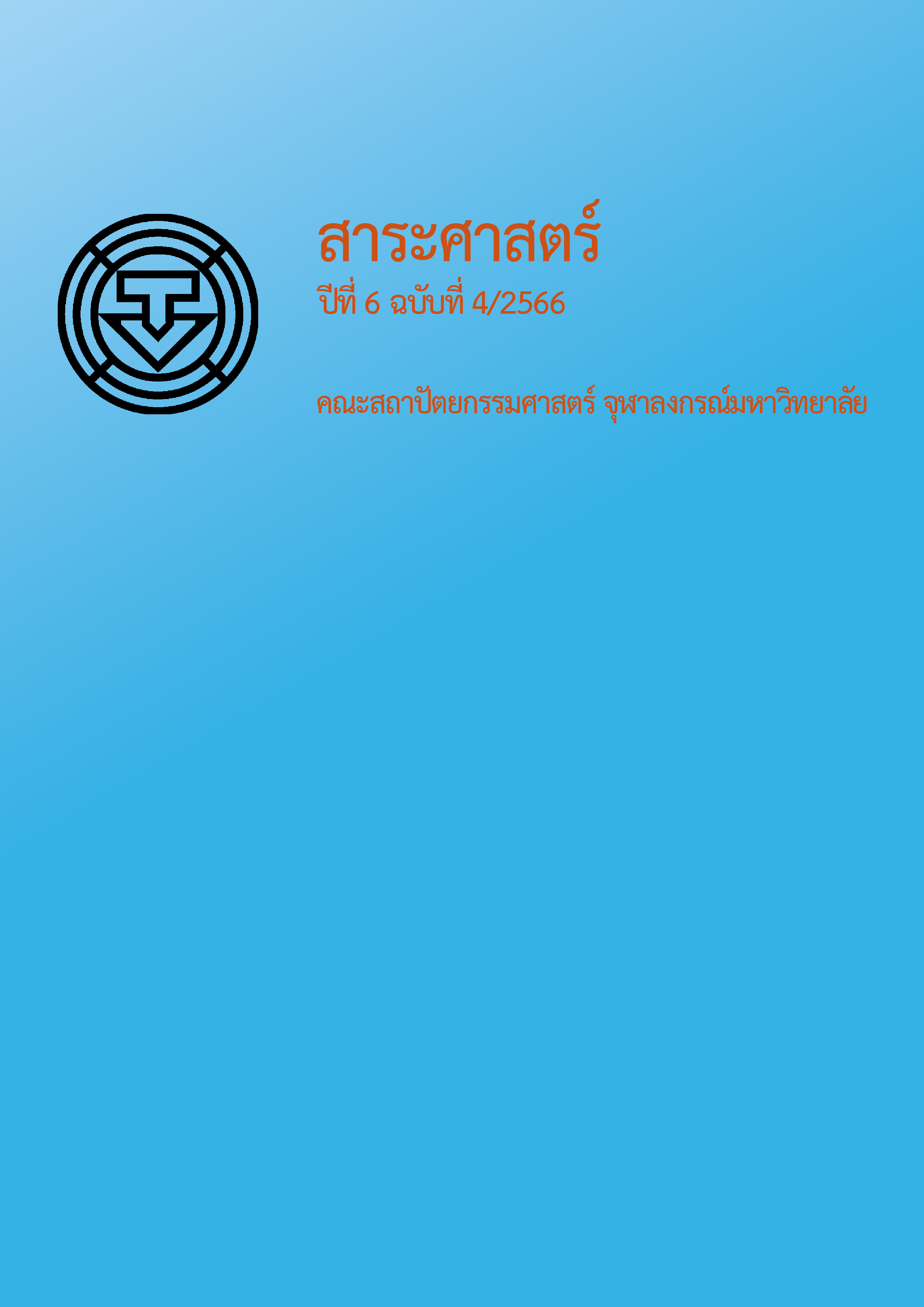Utilization of Automatic Parking in Residential Condominiums, Case Study of Condominiums in Watthana District, Bangkok
Main Article Content
Abstract
The scarcity of parking spaces in residential condominiums poses a significant issue due to inadequate parking availability compared to the number of residential units. This problem is primarily driven by regulations that specify minimum parking requirements, compounded by soaring land prices and spatial constraints. To address this challenge, this paper presents a comprehensive study on automated parking systems as a viable solution to improve parking in condominiums, optimizing space utilization and reducing land expenses. The research centers on a carefully chosen case study conducted in the Wattana district, selected based on predefined criteria. The study objectives encompass examining the concepts and methodologies employed in selecting automated parking system designs for condominium projects, as well as analyzing usage patterns and management practices. Furthermore, the article delves into the advantages and limitations of automated parking systems across various projects. Data was gathered through surveys, observations, and interviews involving stakeholders responsible for implementing automated parking systems. The findings were thoroughly analyzed and compared, resulting in a set of recommendations and guidelines for effectively integrating automated parking systems into residential condominiums.
Through the study, it was found that project developers have the concept of implementing automated parking systems to efficiently utilize limited space and to provide an adequate number of parking spaces as required by law. Each project adopts different approaches in selecting the appropriate design of automated parking systems that best suit the physical characteristics and spatial conditions of the building while considering the cost and price of the automated parking system. Developers and system installers serve as consultants, providing recommendations for system selection. They also arrange for the procurement and installation of the automated parking systems, ensuring the availability of technicians responsible for system maintenance and repairs, and addressing any disruptions in high-traffic projects. Regular monthly maintenance is conducted to ensure the continuous and efficient operation of the automated parking system.
Furthermore, it has been observed that each project exhibits unique advantages, limitations, and common issues. These findings can be examined to offer recommendations for diverse stakeholders with the aim of enhancing and advancing projects that integrate automated parking systems in residential condominiums. Key considerations include usability factors such as convenient parking and vehicle retrieval, optimal positioning of vehicle lifts, an appropriate turning radius, and sufficient waiting space in front of the lifts. Additionally, effective management of the automated parking system is crucial. Safety holds paramount importance, ensuring the safety of users and vehicles through features like self-closing lift doors and the utilization of wheel clamps or barriers to prevent vehicles from sliding or falling off the lifts and parking trays.
Article Details
References
กฎกระทรวง ฉบับที่ 7 (พ.ศ. 2517) ออกตามความในพระราชบัญญัติควบคุมการก่อสร้างอาคาร พุทธศักราช 2479. (2517, 21 พฤษภาคม). ราชกิจจานุเบกษา.เล่ม 91 ตอนที่ 86.
กฎกระทรวง ฉบับที่ 41 (พ.ศ. 2537) ออกตามความในพระราชบัญญัติควบคุมอาคาร พ.ศ. 2522. (2537, 31 สิงหาคม). https://download.asa.or.th/03media/04law/cba/mr37-41.pdf
ข้อบัญญัติกรุงเทพมหานคร เรื่อง ควบคุมอาคาร (พ.ศ. 2544). (2544, 3 สิงหาคม). ราชกิจจานุเบกษา. เล่ม 118 ตอนพิเศษ 75ง.
จิรัฐดิษฐ์ จันทร์หอม และวันมาฆ พรมโชโต. (2562, 7 มิถุนายน). การศึกษาเปรียบเทียบระบบที่จอดรถอัตโนมัติระบบ TOWER PARKING และระบบ MULTI-STORY PARKING. การประชุมวิชาการนักศึกษาระดับชาติ ครั้งที่ 2. สถาบันวิจัยและพัฒนา มหาวิทยาลัยราชภัฏกำแพงเพชร.
G-Park บริษัท ระบบที่จอดรถอัตโนมัติทั่วไป จำกัด. (2566). ทำความรู้จักกับระบบที่จอดรถอัตโนมัติปัจจุบัน 2023-2024,More innovation parking idea, G-Park catalog 2023-2024. https://drive.google.com/file/d/1FjnXEGXjZczfaqSTAq0sgLq2D98dM-M7/view
นพรัตน์ พิริยเลิศศักดิ์. (2555). ที่จอดรถในย่านศูนย์กลางธุรกิจของเมืองเก่า : กรณีศึกษาย่านถนนเยาวราชกรุงเทพมหานคร [วิทยานิพนธ์ปริญญามหาบัณฑิต ไม่ได้ตีพิมพ์]. จุฬาลงกรณ์มหาวิทยาลัย.
บุษกร ลี่สถาพรวงศา. (2563). การเปลี่ยนแปลงทางกายภาพของพื้นที่ส่วนกลางและสิ่งอานวยความสะดวกในอาคารชุดพักอาศัย ในกรุงเทพฯและปริมณฑลระหว่าง พ.ศ. 2536-2561 [วิทยานิพนธ์ปริญญามหาบัณฑิต ไม่ได้ตีพิมพ์]. จุฬาลงกรณ์มหาวิทยาลัย.
Sarun, W., & Bestimate by Bannia. (2565). แผนที่ราคาบ้านและคอนโดมิเนียมในกรุงเทพมหานคร. https://maps.envi.dev/?fbclid=IwAR2TozyOhQF5Rp_F9a2t_m2o5B2ucLJCziSl_fLifsXvoIeE3K6v1j4JPks
สำนักงานนโยบายและแผนทรัพยากรธรรมชาติและสิ่งแวดล้อม. (ม.ป.ป.). รายงานการวิเคราะห์ผลกระทบสิ่งแวดล้อม (EIA). ศูนย์ข้อมูลการประเมินผลกระทบสิ่งแวดล้อม (Smart EIA Plus). http://eia.onep.go.th/
Jog, Y., Sajeev, A., Vidwans, S., & Mallick, C. (2015). Understanding smart and automated parking technology. International Journal of u-and e- Service, Science and Technology, 8(2), 251-262.
THS Parking Solutions. (n.d.). Product & service. https://thsparking.co.th/product


